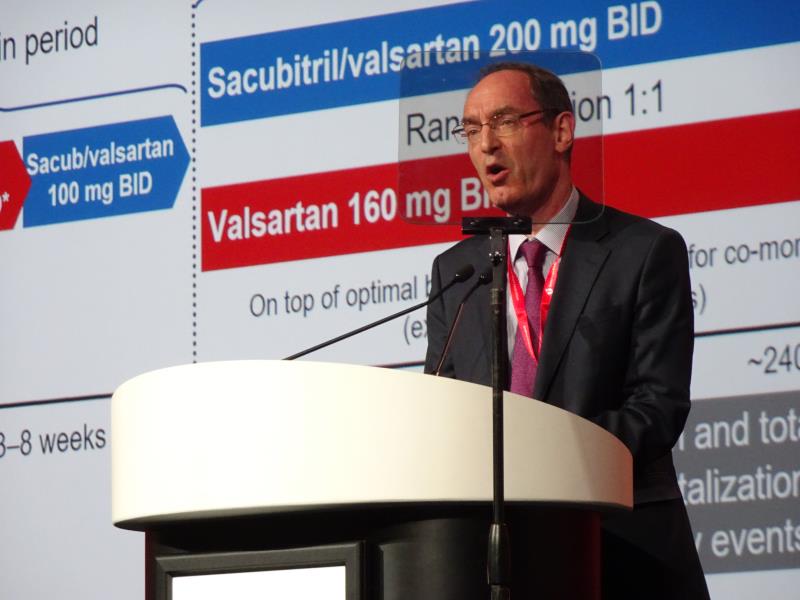 Professor John McMurray
Professor John McMurrayThe impact of sacubitril plus valsartan compared with valsartan alone in reducing heart failure hospitalizations (HHF) in individuals with heart failure with preserved ejection fraction (HFpEF) appears to be greater in women than men, according to a subgroup analysis of the PARAGON-HF* trial.
A total of 2,479 women (mean age 74 years) and 2,317 men (mean age 72 years) with HFpEF (NYHA** class II–IV, EF ≥45 percent) were randomized to receive either sacubitril-valsartan (97 and 103 mg BID, respectively) or valsartan alone (160 mg BID) in addition to optimal background therapy for comorbidities. Use of other angiotensin-converting enzyme inhibitors or angiotensin II receptor blockers was not allowed.
Women were less likely than men to have a history of myocardial infarction (16 percent vs 30 percent) or diabetes (40 percent vs 46 percent), had lower levels of NT-proBNP*** (median 836 vs 954 pg/mL), lower estimated glomerular filtration rate (eGFR) levels (mean 60 vs 65 mL/min/1.73 m2), and lower KCCQ-CSS# scores (71 vs 79).
The primary composite outcome of total (first and recurrent) HHF and cardiovascular (CV) death was significantly reduced with sacubitril-valsartan vs valsartan alone in women (rate ratio [RR], 0.73, 95 percent confidence interval [CI], 0.59–0.90) but not in men (RR, 1.03, 95 percent CI, 0.84–1.25; pinteraction=0.017). [AHA 2019, LBS 5; Circulation 2019;doi:10.1161/CIRCULATIONAHA.119.044491]
This effect of sacubitril-valsartan was driven by a reduction in total HHF in women compared with men (RR, 0.67, 95 percent CI, 0.53–0.85 vs RR, 1.07, 95 percent CI, 0.85–1.34; pinteraction=0.0046), with little difference in the incidence of CV death (hazard ratio [HR], 1.02, 95 percent CI, 0.76–1.36 vs HR, 0.90, 95 percent CI, 0.70–1.17; pinteraction=0.5763).
The improvement in KCCQ-CSS appeared to be lower in women than men at 8 months (-0.6 vs 2.8; pinteraction=0.001), while the improvement in NYHA class with sacubitril-valsartan compared with valsartan alone was similar in men and women (odds ratio [OR], 1.34 and OR, 1.72; pinteraction=0.44). Fewer patients on sacubitril-valsartan than valsartan alone experienced worsening of renal function, defined as a sustained ≥50 percent decrease in eGFR, end-stage renal disease, or renal-related death, which occurred at a similar rate in women and men (HR, 0.49 vs HR, 0.53; pinteraction=0.90). All-cause mortality did not differ between treatments and was comparable between women and men (HR, 0.96 and HR, 0.97, respectively; pinteraction=0.9040).
Adverse events such as hypotension which occurred more often in sacubitril-valsartan than valsartan alone recipients, and elevated creatinine and potassium levels which occurred more often in valsartan than sacubitril-valsartan recipients, did not differ between men and women.
There are currently no effective therapies for HFpEF, which is especially unfortunate for women because HFpEF is the predominant HF phenotype in women, said study author Professor John McMurray from the University of Glasgow, Glasgow, UK.
“Therefore, it was extremely intriguing, interesting, and potentially important that we found that in PARAGON-HF, among the 12 subgroups that we prespecified, two showed effect modification … sex and LVEF##,” he said.
“As compared with valsartan, sacubitril-valsartan seemed to reduce the risk of HHF more in women than in men, but the effects on KCCQ, NYHA class, and worsening kidney function were not greater in women,” he added.
McMurray suggested several mechanisms that could potentially explain this sex-related difference. These include a deficit in cGMP-PKG signalling in postmenopausal women and more systolic dysfunction in women than men at EF of 40–65 percent. It is also possible that an alternative pathology such as cardiac amyloidosis may have led to more male non-responders or that valsartan is more effective in men than women, he said.
As whether the results represent a real effect or are merely a chance finding remains in doubt, further research is warranted in assessing “this possible effect modification of sacubitril-valsartan vs valsartan by sex,” McMurray concluded.